Risk Identification and Conflict Prediction from Videos Based on TTC-ML of a Multi-Lane Weaving Area
Abstract
:1. Introduction
1.1. Background
1.2. Literature Review
1.2.1. Crash Risks Based on Historical Crash Data
1.2.2. Crash Risks Based on Trajectory Data
1.2.3. Driving Behavior and Risk in Weaving Areas
1.3. Challenges
1.4. Objective
2. Methodology
2.1. Research Framework
2.1.1. Video Data Processing
2.1.2. Traffic Risk Identification
2.1.3. Traffic Risk Prediction
2.2. Identification of Traffic Risks
2.2.1. Basic Time-to-Collision
2.2.2. Extended Time-to-Collision
- (1)
- If TTC≤T*, =1, there is a potential collision risk;
- (2)
- If TTC>T*, =0, there is no risk.
2.3. Traffic Conflict Prediction
3. Data
3.1. Data Introduction
3.2. Data Processing
3.2.1. Feature Detection and Tracking
3.2.2. Error Elimination
4. Results and Discussion
4.1. Analysis of Potential Risk Identification Results
4.1.1. Analysis of Results in Different Merging Directions
- (1)
- There are significant differences in the T* distribution of different lanes, the risk distribution of the inner and outer lane 1 and ramp 2 is relatively concentrated, and the risk distribution of the middle 3 lanes is relatively discrete, indicating that the inner and outer lane has less interwoven participation and high traffic priority, which is consistent with actual operation characteristics;
- (2)
- From upstream to downstream T* distribution trend, trajectory gradually evolved from stable continuous disorder, which shows that the shunt demand will lead to vehicle conflict and interference, thus forming traffic bottleneck, congestion and spread to upstream, and from the weaving area close to the downstream, traffic operation state gradually stable, eventually reflects the closer to the downstream, the smaller the potential collision duration gradient phenomenon;
- (3)
- Overall, the potential risks of continuous crossing lanes can be accurately recorded, and the adventure process of individual vehicles entering the directional lane can be accurately captured, indicating that the model can better describe the characteristics of vehicle conflict in the weaving area and verify the effectiveness of the risk discrimination model in this paper.
4.1.2. Analysis of Results from Different Zones
- (1)
- In terms of lanes, the potential risk density of the inner and outer lane is greater than the middle lane, because the inner and outer speed is higher than the middle area. Stable speed, even car-following, low-frequency lane-changing do not necessarily indicate a weak risk, but collaborative “spacing-speed” is the key to safe driving;
- (2)
- In terms of zoning, are the risk heartland. The risk radiates outward in direction and gradually weakens. In addition, the risk associated with the merging of vehicles in cannot be ignored;
- (3)
- (1)
- The conflict severity of each zone is ranked as , , , , , . Among them, (23.59~24.97) unit conflict is the highest, which is about 2–4 times the conflict risk probability of other zones;
- (2)
- The zones ratio of , is not much different from their conflict ratio. However, due to a large number of vehicles in that need to merge into the arterials, the local potential collision risk density is significantly greater than (see Figure 8a), which reflects the weaving conflict characteristics that are different from the basic road sections, and also reflects the model can better describe the distribution characteristics of vehicle conflict density.
4.2. Analysis of Traffic Conflict Prediction Results
4.2.1. Definition of Variables
4.2.2. Validity Test of Traffic Conflict Prediction Model
5. Limitation
6. Conclusions
Author Contributions
Funding
Institutional Review Board Statement
Informed Consent Statement
Data Availability Statement
Conflicts of Interest
References
- Golob, T.E.; Recker, W.W.; Alvarez, V.M. Safety aspects of freeway weaving sections. Transp. Res. Part A-Policy Pract. 2004, 38, 35–51. [Google Scholar] [CrossRef] [Green Version]
- Hidas, P. Modelling vehicle interactions in microscopic simulation of merging and weaving. Transp. Res. Part C-Emerg. Technol. 2005, 13, 37–62. [Google Scholar] [CrossRef]
- Mao, X.; Yuan, C.; Gan, J.; Zhang, S. Risk factors affecting traffic accidents at urban weaving sections: Evidence from China. Int. J. Environ. Res. Public Health 2019, 16, 1542. [Google Scholar] [CrossRef] [PubMed] [Green Version]
- Gu, X.; Abdel-Aty, M.; Xiang, Q.; Cai, Q.; Yuan, J. Utilizing UAV video data for in-depth analysis of drivers’ crash risk at interchange merging areas. Accid. Anal. Prev. 2019, 123, 159–169. [Google Scholar] [CrossRef]
- Yuan, J.; Abdel-Aty, M.; Cai, Q.; Lee, J. Investigating drivers’ mandatory lane change behavior on the weaving section of freeway with managed lanes: A driving simulator study. Transp. Res. Part F-Traffic Psychol. Behav. 2019, 62, 11–32. [Google Scholar] [CrossRef]
- Sun, J.; Zuo, K.; Jiang, S.; Zheng, Z. Modeling and predicting stochastic merging behaviors at freeway on-ramp bottlenecks. J. Adv. Transp. 2018, 2018, 9308580. [Google Scholar] [CrossRef] [Green Version]
- Xu, J.; Lin, W.; Wang, X.; Shao, Y. Acceleration and deceleration calibration of operating speed prediction models for two-lane mountain highways. J. Transp. Eng. Part A Syst. 2017, 143, 04017024. [Google Scholar] [CrossRef]
- Savolainen, P.T.; Mannering, F.L.; Lord, D.; Quddus, M.A. The statistical analysis of highway crash-injury severities: A review and assessment of methodological alternatives. Accid. Anal. Prev. 2011, 43, 1666–1676. [Google Scholar] [CrossRef] [Green Version]
- Kopelias, P.; Papadimitriou, F.; Papandreou, K.; Prevedouros, P. Urban freeway crash analysis: Geometric, operational, and weather effects on crash number and severity. Transp. Res. Rec. 2015, 9, 123–131. [Google Scholar] [CrossRef]
- Tay, R.; Rifaat, S.M. Factors contributing to the severity of intersection crashes. J. Adv. Transp. 2007, 41, 245–265. [Google Scholar] [CrossRef]
- Caliendo, C.; De Guglielmo, M.L.; Guida, M. Comparison and analysis of road tunnel traffic accident frequencies and rates using random-parameter models. J. Transp. Saf. Secur. 2016, 8, 177–195. [Google Scholar] [CrossRef]
- Li, X.; Liu, J.; Khattak, A.; Nambisan, S. Sequential prediction for large-scale traffic incident duration: Application and comparison of survival models. Transp. Res. Rec. 2020, 2674, 79–93. [Google Scholar] [CrossRef]
- Wang, L.; Abdel-Aty, M. Microscopic safety evaluation and prediction for free-way-to-freeway interchange ramps. Transp. Res. Rec. 2016, 2583, 56–64. [Google Scholar] [CrossRef]
- Guo, Y.; Li, Z.; Sayed, T. Analysis of crash rates at freeway diverge areas using Bayesian tobit modeling framework. Transp. Res. Rec. 2019, 2673, 652–662. [Google Scholar] [CrossRef]
- Li, X.; Liu, J.; Yang, C.; Barnett, T. Bayesian approach to developing context-based crash modification factors for medians on rural four-lane roadways. Transp. Res. Rec. 2021, 2675, 1316–1330. [Google Scholar] [CrossRef]
- Sun, J.; Sun, J. Real-time crash prediction on urban expressways: Identification of key variables and a hybrid support vector machine model. IET Intell. Transp. Syst. 2016, 10, 331–337. [Google Scholar] [CrossRef]
- Sun, J.; Li, T.; Li, F.; Chen, F. Analysis of safety factors for urban expressways considering the effect of congestion in Shanghai, China. Accid. Anal. Prev. 2016, 95, 503–511. [Google Scholar] [CrossRef]
- Wang, L.; Abdel-Aty, M.; Lee, J.; Shi, Q. Analysis of real-time crash risk for expressway ramps using traffic, geometric, trip generation, and socio-demographic predictors. Accid. Anal. Prev. 2019, 122, 378–384. [Google Scholar] [CrossRef]
- Waseem, M.; Ahmed, A.; Saeed, T.U. Factors affecting motorcyclists’ injury severities: An empirical assessment using random parameters logit model with heterogeneity in means and variances. Accid. Anal. Prev. 2019, 123, 12–19. [Google Scholar] [CrossRef]
- Saeed, T.U.; Hall, T.; Baroud, H.; Volovski, M.J. Analyzing road crash frequencies with uncorrelated and correlated random-parameters count models: An empirical assessment of multilane highways. Anal. Methods Accid. Res. 2019, 23, 100101. [Google Scholar] [CrossRef]
- Chen, S.; Saeed, T.U.; Alqadhi, S.D.; Labi, S. Safety impacts of pavement surface roughness at two-lane and multi-lane highways: Accounting for heterogeneity and seemingly unrelated correlation across crash severities. Transp. A 2019, 15, 18–33. [Google Scholar] [CrossRef]
- Chen, S.; Saeed, T.U.; Alinizzi, M.; Lavrenz, S.; Labi, S. Safety sensitivity to roadway characteristics: A comparison across highway classes. Accid. Anal. Prev. 2019, 123, 39–50. [Google Scholar] [CrossRef] [PubMed]
- Chen, Q.; Gu, R.; Huang, H.; Lee, J.; Zhai, X.; Li, Y. Using vehicular trajectory data to explore risky factors and unobserved heterogeneity during lane-changing. Accid. Anal. Prev. 2021, 151, 105871. [Google Scholar] [CrossRef] [PubMed]
- Chen, Q.H.; Huang, H.; Li, Y.; Lee, J.; Long, K.J.; Gu, R.; Zhai, X. Modeling accident risks in different lane-changing behavioral patterns. Anal. Methods Accid. Res. 2021, 30, 100159. [Google Scholar] [CrossRef]
- Sharma, K.; Poonia, R.; Sunda, S. Accurate Real-Time Location Map Matching Algorithm for Large Scale Trajectory Data. In Proceedings of the 7th International Conference on Reliability, Infocom Technologies and Optimization (Trends and Future Directions) (ICRITO), Noida, India, 29–31 August 2018; pp. 646–651. [Google Scholar]
- Xing, L.; He, J.; Abdel-Aty, M.; Cai, Q.; Li, Y.; Zheng, O. Examining traffic conflicts of up stream toll plaza area using vehicles’ trajectory data. Accid. Anal. Prev. 2019, 125, 174–187. [Google Scholar] [CrossRef]
- Yang, Z.; Yu, Q.; Zhang, W.; Shen, H. A comparison of experienced and novice drivers’ rear-end collision avoidance maneuvers under urgent decelerating events. Transp. Res. Part F-Traffic Psychol. Behav. 2021, 76, 353–368. [Google Scholar] [CrossRef]
- Schwarz, C. On computing time-to-collision for automation scenarios. Transp. Res. Part F 2014, 27, 283–294. [Google Scholar] [CrossRef]
- Schleinitz, K.; Petzoldt, T.; Gehlert, T. Drivers’ gap acceptance and time to arrival judgements when confronted with approaching bicycles, e-bikes, and scooters. J. Transp. Saf. Secur. 2020, 12, 3–16. [Google Scholar] [CrossRef]
- Oh, C.; Kim, T. Estimation of rear-end crash potential using vehicle trajectory data. Accid. Anal. Prev. 2010, 42, 1888–1893. [Google Scholar] [CrossRef]
- Yang, H.; Ozbay, K. 2011.Estimation of traffic conflict risk for merging vehicles on highway merge section. Trans. Res. Rec. 2011, 2236, 58–65. [Google Scholar] [CrossRef]
- Li, H.; Zhang, J.; Zhang, Z.; Huang, Z. Active lane management for intelligent connected vehicles in weaving areas of urban expressway. J. Intell. Connect. Veh. 2021, 4, 52–67. [Google Scholar] [CrossRef]
- Abdel-Aty, M.; Wang, L. Implementation of variable speed limits to improve safety of congested expressway weaving segments in microsimulation. Transp. Res. Procedia 2017, 27, 577–584. [Google Scholar] [CrossRef]
- Hao, W.; Zhang, Z.; Gao, Z.; Yi, K.; Liu, L.; Wang, J. Research on mandatory lane-changing behavior in highway weaving sections. J. Adv. Transp. 2020, 2020, 3754062. [Google Scholar] [CrossRef]
- Chen, X.; Yu, L.; Jia, X. Capacity Modeling for Weaving, Merge, and Diverge Sections with Median Exclusive Bus Lanes on an Urban Expressway: Microsimulation Approach. Trans. Res. Rec. 2016, 2553, 99–107. [Google Scholar] [CrossRef]
- Wang, L.; Abdel-Aty, M.; Shi, Q.; Park, J. Real-time crash prediction for express-way weaving segments. Transp. Res. Part C-Emerg. Technol. 2015, 61, 1–10. [Google Scholar] [CrossRef]
- Wang, H.; Wang, W.; Yuan, S.; Li, X.; Sun, L. On social interactions of merging behaviors at highway on-Ramps in congested traffic. IEEE Trans. Intell. Transp. Syst. 2021, 7, 1–12. [Google Scholar] [CrossRef]
- Hu, Y.; LI, Y.; Huang, H.; Lee, J.; Yuan, C.; Zou, G. A high-resolution trajectory data driven method for real-time evaluation of traffic safety. Accid. Anal. Prev. 2021, 165, 106503. [Google Scholar] [CrossRef]
- Chen, X.; Li, Z.; Yang, Y.; Qi, L.; Ke, R. High-resolution vehicle trajectory extraction and denoising from aerial videos. IEEE Trans. Intell. Transp. Syst. 2020, 22, 3190–3202. [Google Scholar] [CrossRef]
- Pearl, J. Reasoning under Uncertainty. Annu. Rev. Comput. Sci. 2003, 4, 37–72. [Google Scholar] [CrossRef]
- Tang, L.L.; Yang, X.; Kan, Z.H. Traffic Lane Numbers Detection Based on the Naive Bayesian Classification. China J. Highw. Transp. 2016, 29, 116–123. [Google Scholar]
- Yang, W.C.; Xie, B.S.; Fang, R. Comparative Analysis and Prediction of Motor Vehicle Crash Severity on Mountainous Two-lane Highways. J. Transp. Syst. Eng. Inf. Technol. 2021, 21, 190–195. [Google Scholar]
- Friedman, J.H. Greedy Function Approximation: A Gradient Boosting Machine. Ann. Stat. 2001, 29, 1189–1232. [Google Scholar] [CrossRef]
- Mahmud, S.M.S.; Ferreira, L.; Hoque, M.S.; Tavassoli, A. Application of proximal surrogate indicators for safety evaluation: A review of recent developments and research needs. IATSS Res. 2017, 41, 153–163. [Google Scholar] [CrossRef]
- Cai, Q.; Saad, M.; Abdel-Aty, M.; Yuan, J.; Lee, J. Safety impact of weaving distance on freeway facilities with managed lanes using both microscopic traffic and driving simulations. Transp. Res. Rec. 2018, 2672, 130–141. [Google Scholar] [CrossRef]
- Hayward, J.C. Near-miss determination through use of a scale of danger. Highw. Res. Rec. 1972, 384, 24–34. [Google Scholar]
- Li, Y.; Li, Z.; Wang, H.; Wang, W.; Xing, L. Evaluating the safety impact of adaptive cruise control in traffic oscillations on freeways. Accid. Anal. Prev. 2017, 104, 137–145. [Google Scholar] [CrossRef]
- Li, Y.; Xu, C.C.; Xing, L.; Wang, W. Integrated cooperative adaptive cruise and variable speed limit controls for reducing rear-end collision risks near freeway bottlenecks based on micro-simulations. IEEE Trans. Intell. Transp. Syst. 2017, 18, 3157–3167. [Google Scholar] [CrossRef]
- Li, Y.; Wu, D.; LEE, J.; Yang, M.; Shi, Y. Analysis of the transition condition of rear-end collisions using time-to-collision index and vehicle trajectory data. Accid. Anal. Prev. 2020, 144, 105676. [Google Scholar] [CrossRef]
- Ward, J.R.; Agamennoni, G.; Worrall, S.; Bender, A.; Nebot, E. Extending Time to Collision for probabilistic reasoning in general traffic scenarios. Transp. Res. Part C-Emerg. Technol. 2015, 51, 66–82. [Google Scholar] [CrossRef]
- Peng, B.; Wang, Y.T.; Xie, J.M.; Zhang, Y.; Tang, J. Multi-stage Lane Changing Decision Model of Urban Trunk Road’s Short Weaving Area Based on Cellular Automata. J. Transp. Syst. Eng. Inf. Technol. 2020, 20, 41–48. [Google Scholar]
- Han, S.; Lan, D.; Gui, Q.; Du, L. Characteristics Analysis Approach for Multicollinearity Diagnosis and Its Applications in Orbit Determination of GEO Satellites. Acta Geod. Cartogr. Sin. 2013, 42, 19–26. [Google Scholar]
- Zhu, Y.; Zheng, Y.; Yin, M. Multicollinearity Test Under Statistical Significance. Stat. Decis. 2020, 36, 3. [Google Scholar]
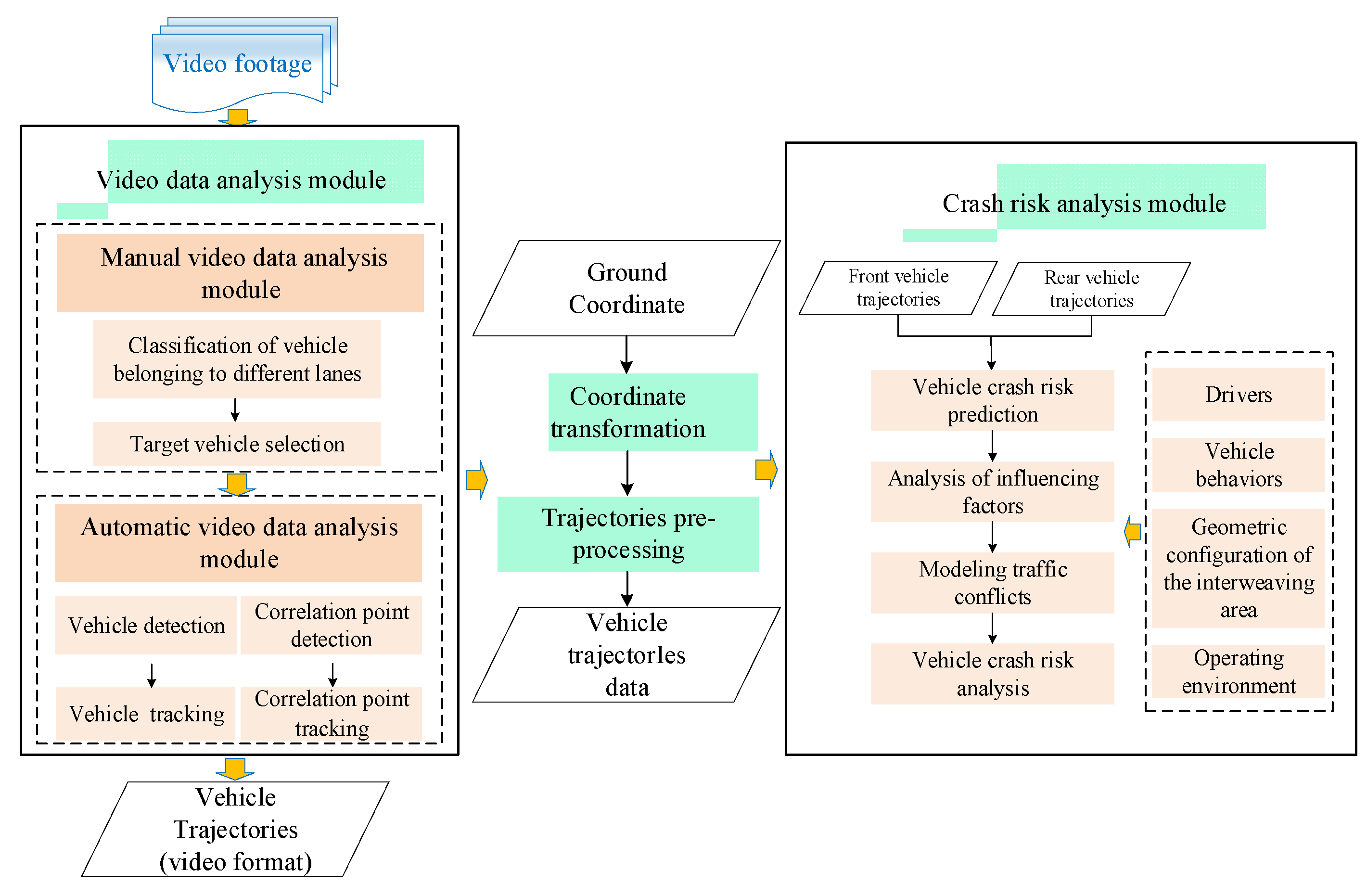
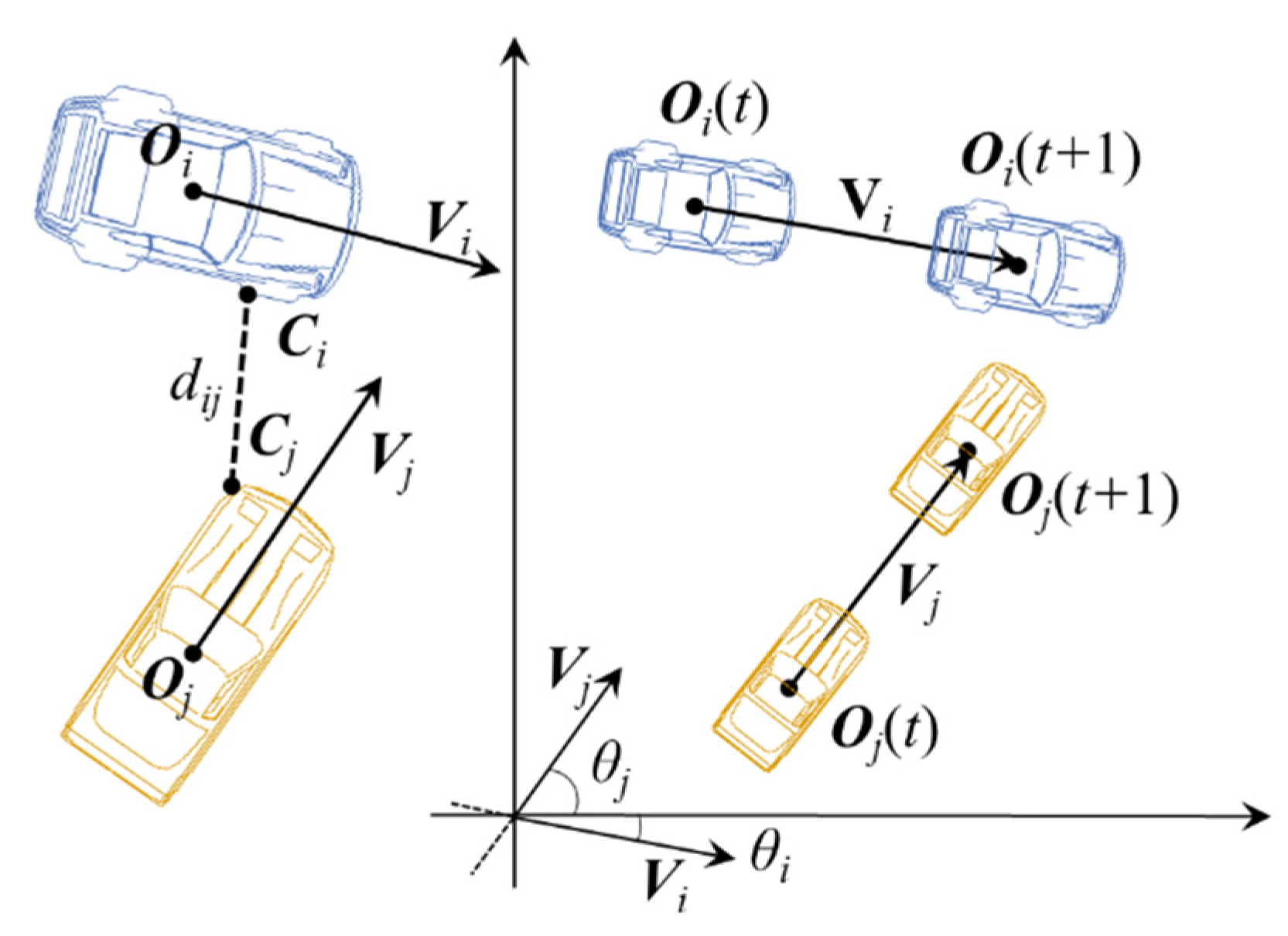

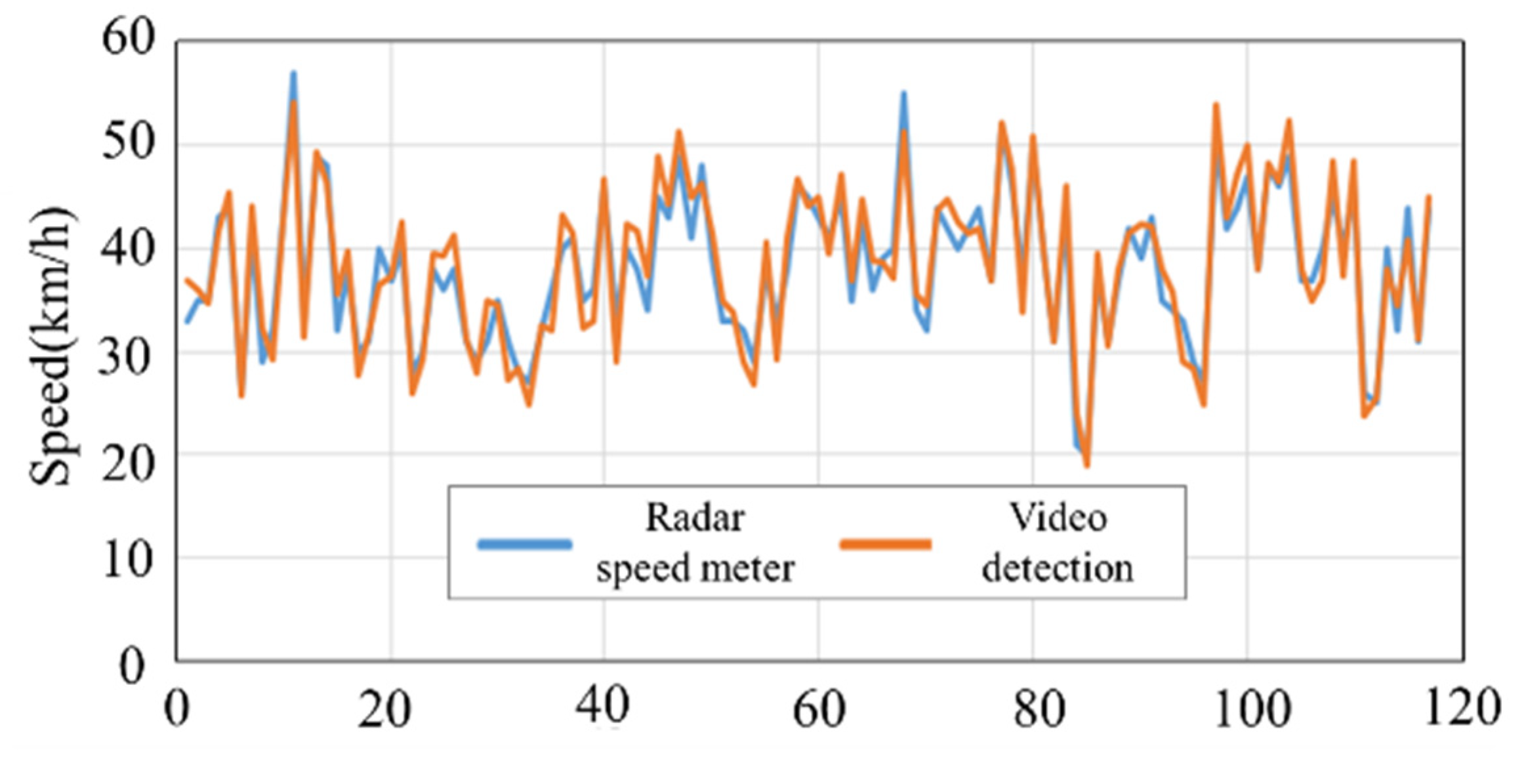
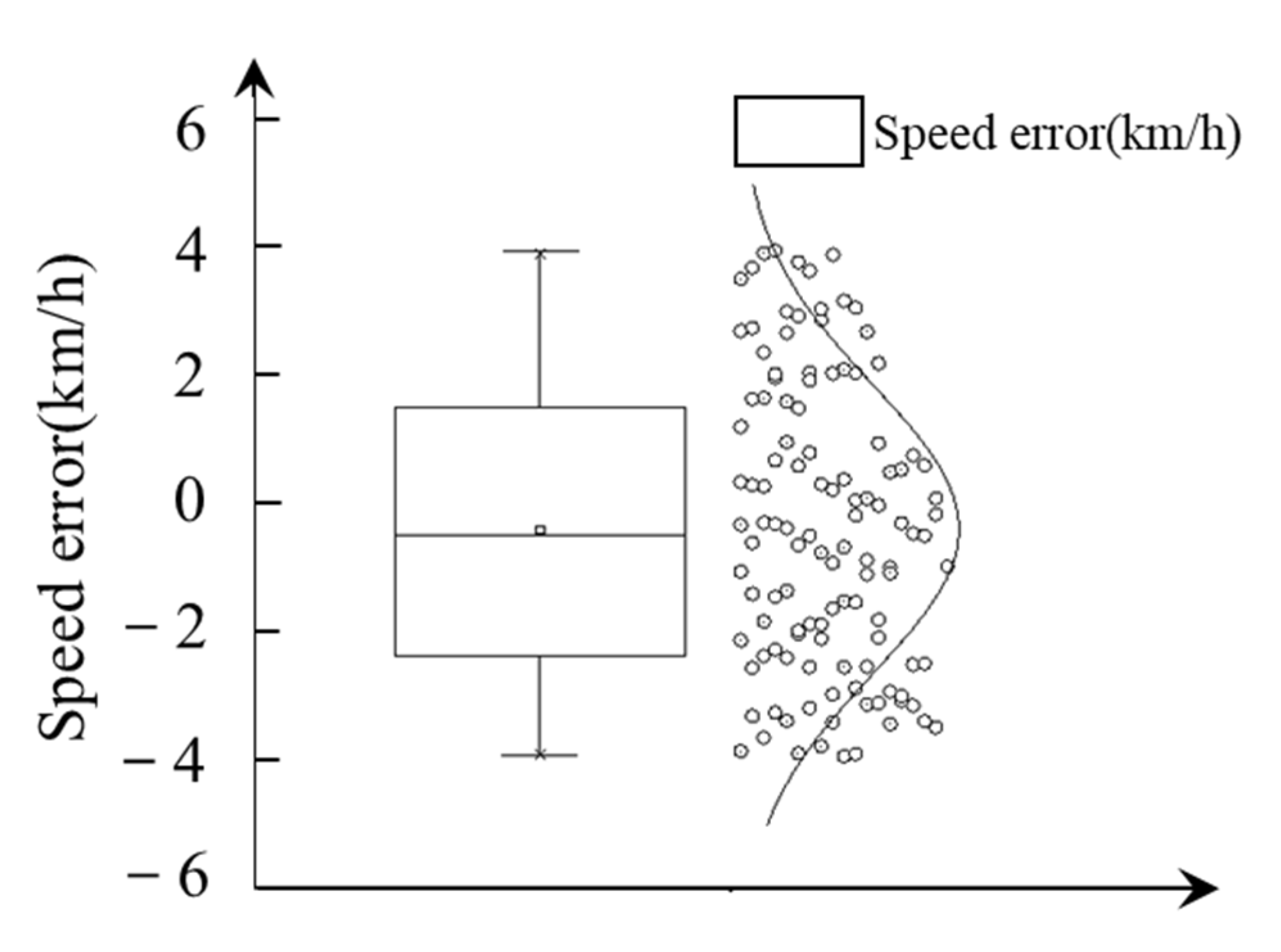
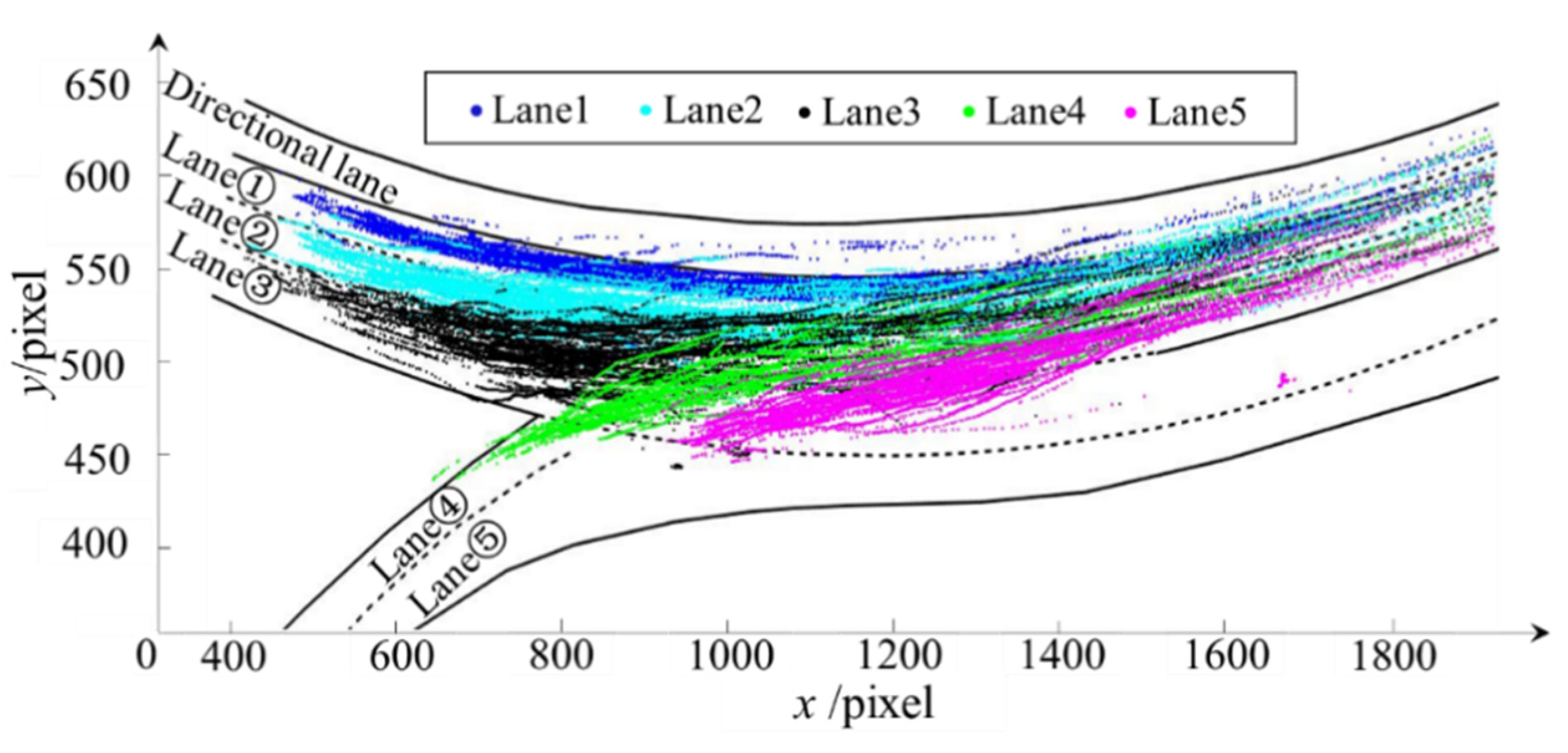
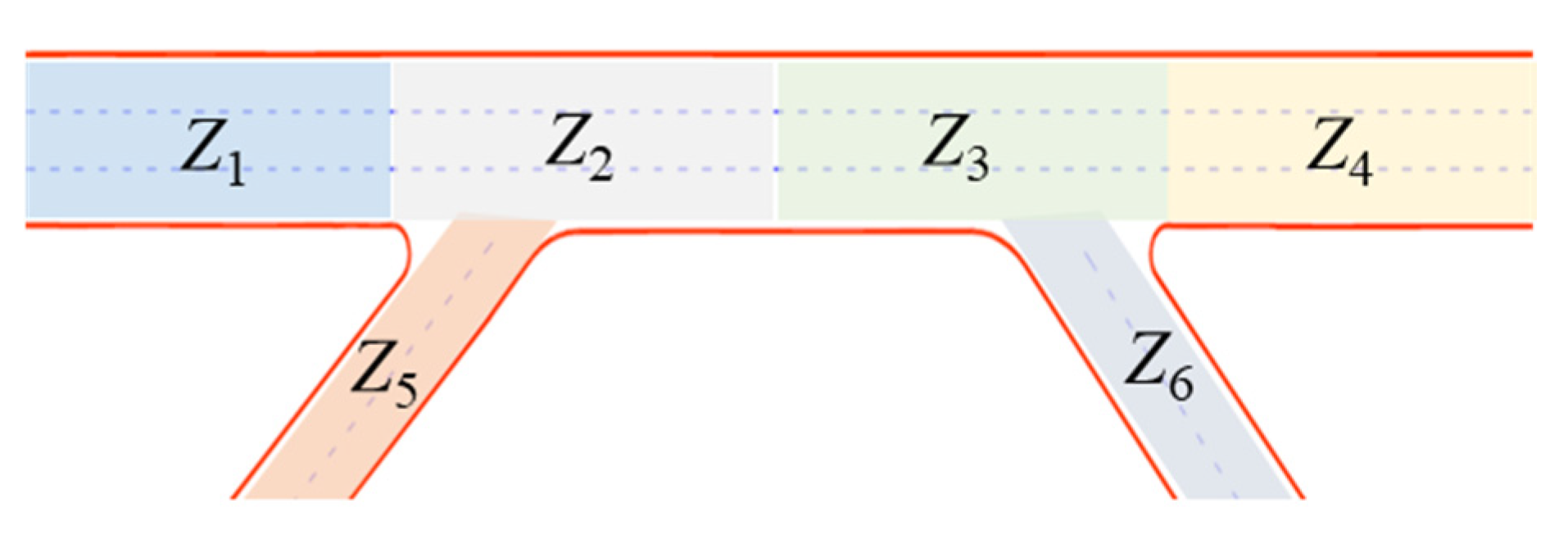
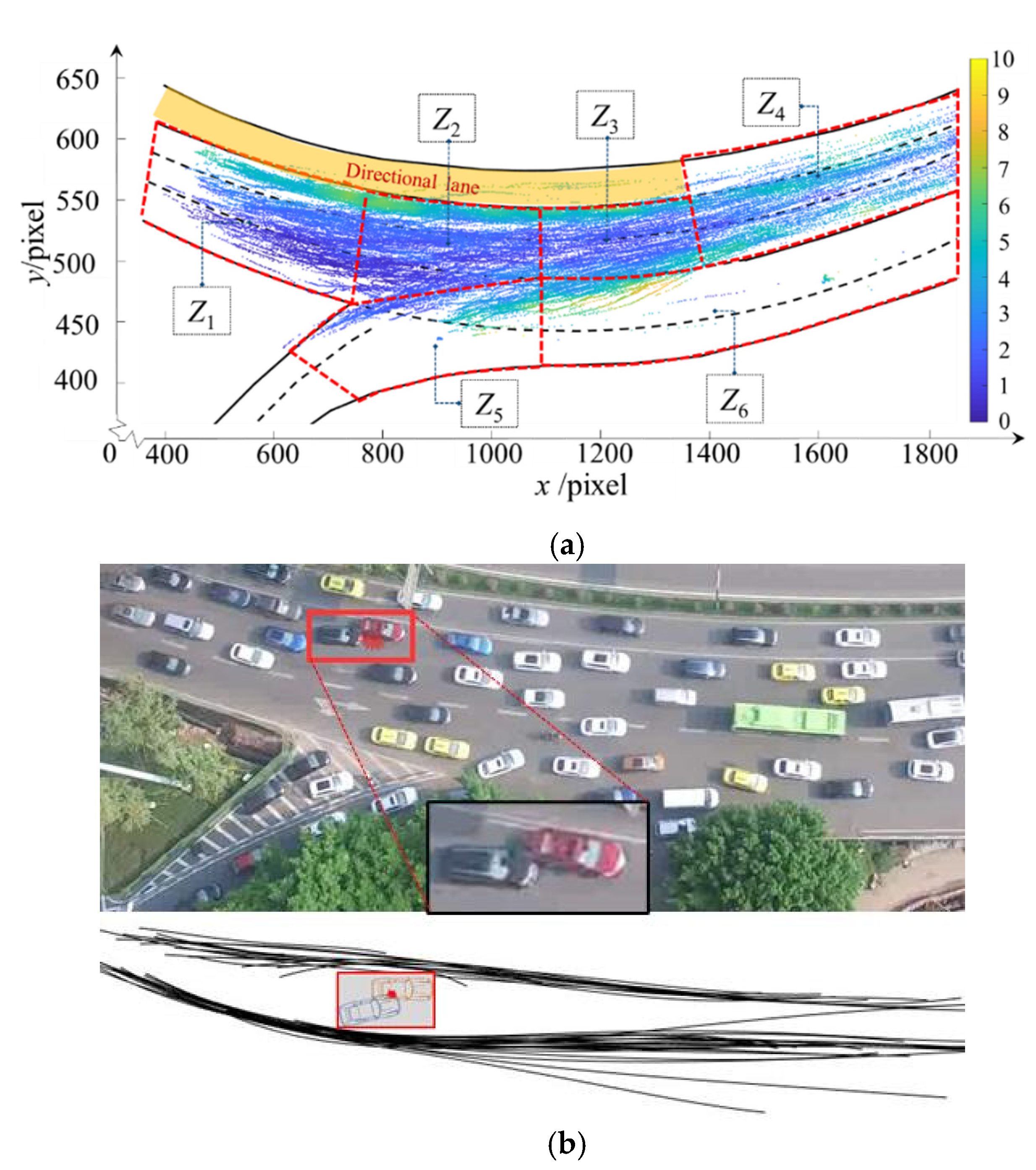



| Research Gap | Studies | |
|---|---|---|
| Data | Costly and unreliable access to publicly available crash data. | Guo et al., (2019) [14]; Wang et al., (2019) [18] |
| The sample size in the surveillance camera is not comprehensive and it is difficult to extract the trajectory data. | Chen et al., (2021) [24]; Xing et al., (2019) [26]; Yang et al., (2021) [27] | |
| Subjects | Incomplete studies of crash risk in weaving area. | Sun et al., (2016) [15]; Wang et al., (2015) [36] |
| Time (s) | Lane ID | Vehicle ID | Longitude Position (Pixel) | Latitude Position (Pixel) | Gap (m) | Speed (m·s−1) | Acceleration (m·s−2) | Density (pcu·Lane−1·km−1) |
|---|---|---|---|---|---|---|---|---|
| 0.1 | 2 | 1 | 1409 | 600 | 2.95 | 5.578 | 0.156 | 90 |
| 0.2 | 2 | 1 | 1412 | 600 | 2.43 | 3.000 | −2.578 | 90 |
| 0.3 | 2 | 1 | 1418 | 600 | 1.90 | 6.000 | 3.000 | 91 |
| 0.4 | 2 | 1 | 1425 | 602 | 1.06 | 7.280 | 1.280 | 91 |
| 0.5 | 2 | 1 | 1430 | 605 | 0.53 | 5.831 | −1.449 | 91 |
| Zones | Potential Collision Per-Unit Area/(Sub m−2) | The Ratio of TTC* | |
|---|---|---|---|
| 14.81 | 16.97% | 19.12% | |
| 23.59 | 13.14% | 23.58% | |
| 24.97 | 8.69% | 16.50% | |
| 8.21 | 21.79% | 13.61% | |
| 14.28 | 14.69% | 15.96% | |
| 5.97 | 24.72% | 11.23% |
| Classification of Variables | Meaning and Symbols of Variables |
|---|---|
| Vehicle i | at which vehicle i enters (leaves) the research area |
| in which vehicle i enters (leaves) the research area | |
| of speed | |
| of acceleration | |
| of angular velocity |
| Metric Name | Naive Bayes | Logistic Regression | Gradient Boosting Decision Tree |
|---|---|---|---|
| Accuracy/% | 74.86 | 87.10 | 95.1 |
| Precision/% | 38.86 | 67.76 | 87.6 |
| Sensitivity/% | 79.87 | 48.04 | 83.6 |
| FPR/% | 26.19 | 4.76 | 2.5 |
Publisher’s Note: MDPI stays neutral with regard to jurisdictional claims in published maps and institutional affiliations. |
© 2022 by the authors. Licensee MDPI, Basel, Switzerland. This article is an open access article distributed under the terms and conditions of the Creative Commons Attribution (CC BY) license (https://creativecommons.org/licenses/by/4.0/).
Share and Cite
Xia, Y.; Qin, Y.; Li, X.; Xie, J. Risk Identification and Conflict Prediction from Videos Based on TTC-ML of a Multi-Lane Weaving Area. Sustainability 2022, 14, 4620. https://doi.org/10.3390/su14084620
Xia Y, Qin Y, Li X, Xie J. Risk Identification and Conflict Prediction from Videos Based on TTC-ML of a Multi-Lane Weaving Area. Sustainability. 2022; 14(8):4620. https://doi.org/10.3390/su14084620
Chicago/Turabian StyleXia, Yulan, Yaqin Qin, Xiaobing Li, and Jiming Xie. 2022. "Risk Identification and Conflict Prediction from Videos Based on TTC-ML of a Multi-Lane Weaving Area" Sustainability 14, no. 8: 4620. https://doi.org/10.3390/su14084620
APA StyleXia, Y., Qin, Y., Li, X., & Xie, J. (2022). Risk Identification and Conflict Prediction from Videos Based on TTC-ML of a Multi-Lane Weaving Area. Sustainability, 14(8), 4620. https://doi.org/10.3390/su14084620







